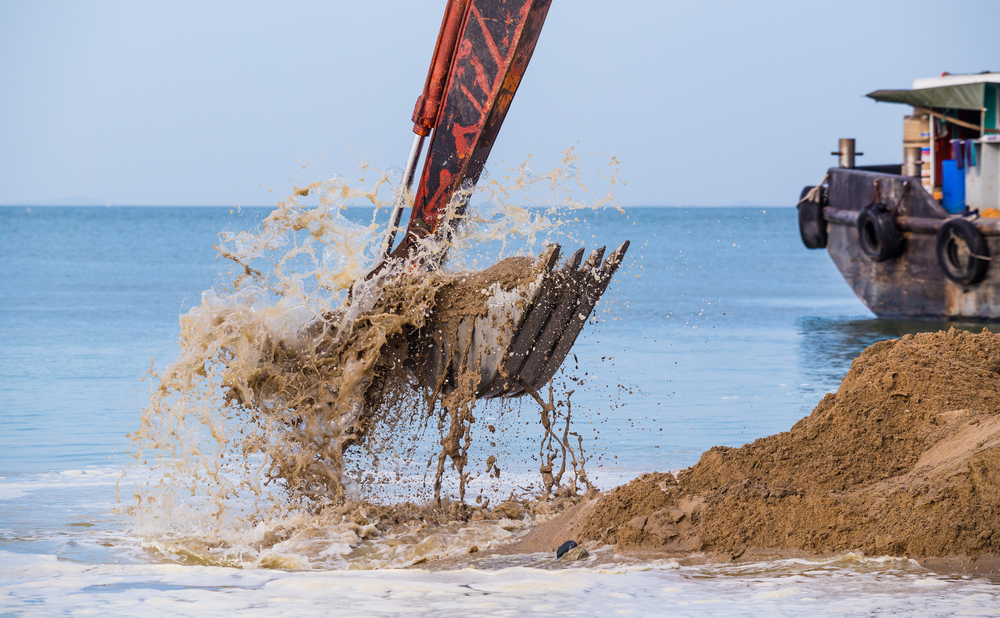
We’ve previously talked about the heavy carbon footprint of the world’s most used construction material, concrete. You might remember that concrete is a composite material made of fine and coarse aggregate bound together by a liquid binder that hardens or cures over time. That aggregate, more often than not, is sand. Sand is the world’s most mined material with an estimated 50 billion tons extracted from lakes, riverbeds, coastlines, and deltas each year, according to the United Nations Environment Programme.
Where is all that sand going?
Sand is not only used for concrete production, but also in the production of abrasives, absorbents, asphalt, ceramics, chemicals, fracking fluid, electronics (including the silicon chips in phones and computers), filtration media, glass (every window, windshield, and smart phone screen), land reclamation, paint, metal castings, pigments, and synthetic fibers—just to name a few.
Whatever. There’s plenty of sand on the planet… right?
Sand can indeed be found in every country on Earth, in rivers, lakes, the ocean, and lining the coastlines of our planet. But not all sand is created equal. Desert sand, although abundant, is not suitable for construction because of its rounded shape created by wind erosion. These smooth grains are unable to bind together for construction use. Even Dubai, which sits on the edge of a desert full of sand, imports sand from Australia, because it has exhausted its marine sand supply. In fact, in 2014, according to the United Nations the United Arab Emirates imported $456 million USD of sand, stone, and gravel.
Sand eroded by water, on the other hand, is more angular and the grains are able to lock together to create a strong, stable building material. It is typically sourced and extracted from seabeds, coastlines, quarries, and rivers around the world. River sand is preferable to marine sand, as marine sand has to be washed clean of salt that could otherwise corrode metal in structural building reinforcements. River sand is also the source of the silica sand needed to make glass.
But won’t the Earth just keep making more sand?
Sure! But not anytime soon enough to replace the quantity we’re using. Sand is considered a non-renewable resource in our lifetime. Sand forms when rocks break down from weathering and eroding over thousands and even millions of years. Rocks take time to decompose and that time will vary with the type of rock. Often starting thousands of miles from the ocean, rocks slowly travel down rivers and streams, constantly breaking down along the way. Once they make it to the ocean, they further erode from the constant action of waves and tides. Different colored sand is the result of different geological and ecological processes. Black sand is the result of eroded volcanic material while the famous white sand beaches of Hawaii and other tropical locales are actually the result of parrot fish. Parrot fish nibble on rock and coral to feed on algae and the inedible reef material is excreted as sand. Scientists estimate that more than 80% of the sand around tropical coral reefs is parrotfish poop! As a side note, parrot fish are listed as vulnerable to localized extinction.
What’s the big deal with sand mining anyways?
The method of sand mining extraction depends on where the sand is located. On land or along rivers, it is often dug up with backhoes, shovels, or bare hands. Along coastlines, miners use dredging boats or suction pumps. In 2019, a report by the UNEP revealed that sand extraction in rivers has led to pollution, flooding, lowering of water aquifers, and worsening drought occurrence. Coastal sand mining has destroyed fisheries and ecosystems, disturbed corals, and eroded coastlines, making them more vulnerable to the effects of storms.
As mining bans have been implemented in vulnerable areas, UNEP also warns of thriving “sand mafias,” with groups comprised of builders, dealers, and businessmen known to be operating in countries such as Cambodia, Vietnam, Kenya, and Sierra Leone. Activists working to shine a light on their activities, UNEP said, are being threatened and even killed.

So what do we do?
How do you solve a supply and demand issue? Reduce the demand. We can reduce the consumption of sand by optimizing the use of existing buildings and infrastructure. We can recycle concrete as well as glass. We can find alternatives to sand like quarry dust and incinerator ash. Currently, sand extraction and use is defined by its local geography and governance context and does not have the same rules, practices, and ethics worldwide. To meet demand in an ever-growing world without harming the environment, effective policy, planning, regulation, and management are required.



